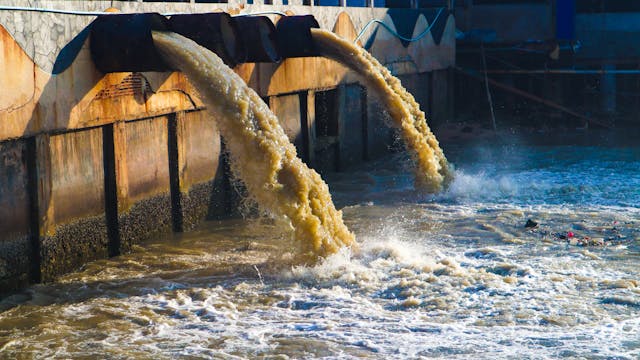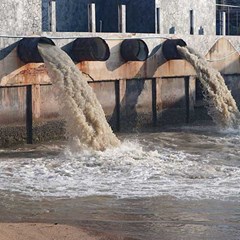Industrial Waste Water Treatment-- Comprehensive Solutions for Wastewater Disposal
Wiki Article
Difficulties and Solutions in Industrial Waste Water Therapy
The therapy of industrial wastewater presents a multifaceted variety of obstacles, ranging from stringent regulative conformity to the intricacies of price monitoring and technical limitations. The irregularity in waste composition further makes complex the efficiency of typical treatment techniques, frequently resulting in risen functional expenditures. However, emerging options such as advanced oxidation processes and cutting-edge funding models show promise in addressing these issues. As markets come to grips with the requirement for sustainable techniques, the question remains: what approaches will ultimately cause an equilibrium in between compliance, cost-efficiency, and ecological duty?Regulatory Compliance Obstacles
Exactly how can commercial facilities navigate the facility landscape of regulative compliance in wastewater treatment? The regulatory framework controling wastewater management is complex, frequently differing by territory and sort of industry. Facilities should stick to federal, state, and regional policies that dictate effluent high quality criteria, discharge limits, and tracking needs. Failing to conform can cause extreme fines, consisting of fines and operational shutdowns.To effectively take care of these compliance obstacles, centers should execute durable monitoring and reporting systems that make certain real-time information collection and analysis. Routine audits and danger assessments can determine potential conformity spaces, permitting proactive changes in therapy processes. Staff member training programs concentrating on governing knowledge and best techniques are vital to foster a society of conformity within the company.
Additionally, engaging with regulatory agencies can provide valuable understandings and make clear ambiguous guidelines. Facilities might also take advantage of talking to environmental professionals who focus on wastewater treatment compliance, ensuring that they stay informed of progressing laws. By adopting these approaches, commercial centers can not only fulfill compliance demands yet additionally boost their functional efficiency and environmental stewardship.
Price and Economic Obstacles
Browsing regulatory conformity in wastewater therapy frequently provides considerable economic obstacles for commercial facilities. The costs connected with implementing needed treatment technologies, maintaining compliance with stringent regulations, and handling functional expenses can be discouraging. Many organizations deal with high preliminary capital expenses for the building or upgrading of wastewater treatment plants, which may stress spending plans, especially for medium-sized and small ventures.In addition, continuous functional prices, consisting of upkeep, labor, and chemical inputs, add to the financial concern. The unpredictability of fluctuating energy prices and the possible requirement for additional financial investments to fulfill progressing policies aggravate these financial stress. In most cases, the lack of monetary incentives or assistance from government bodies makes it much more difficult for businesses to justify investments in advanced treatment systems.
Furthermore, the financial practicality of wastewater treatment solutions is commonly questioned, particularly for industries with tight profit margins. As a result, it is important for industrial centers to discover affordable approaches, such as embracing innovative financing alternatives, participating in collaborations, and leveraging arising innovations that can help mitigate these financial obstacles while ensuring compliance with environmental criteria.

Technological Limitations
Numerous technical limitations hinder the efficiency of commercial wastewater therapy procedures. One substantial obstacle is the insufficiency of existing therapy modern technologies to address intricate pollutants. Numerous standard techniques, such as triggered sludge and chemical precipitation, battle with the removal of emerging contaminants, consisting of drugs and microplastics. This limitation commonly results in the discharge of inadequately dealt with water, which can have destructive environmental effects.In addition, the scalability of therapy technologies postures an obstacle. While some sophisticated methods, like membrane purification or advanced oxidation, reveal promise in regulated environments, their execution on a bigger range can be practically difficult and excessively pricey. Upkeep and functional intricacies further make complex the fostering of these systems, particularly for smaller sectors with restricted technological know-how.
The integration of real-time monitoring technologies also stays inadequate in lots of treatment centers. Without reliable monitoring systems, drivers can not adequately examine therapy efficiency or spot prospective failings, leading to irregular effluent high quality. Resolving these technological limitations through research and growth, alongside financial investment in ingenious options, is vital for boosting the efficiency of commercial wastewater therapy and making sure regulative compliance.
Irregularity in Waste Composition
In the world of industrial wastewater treatment, the variability in waste composition presents an awesome challenge. Industries generate wastewater with varied features, affected by variables such as production procedures, basic materials, and operational methods. This diversification makes complex the treatment process, as conventional systems frequently have a hard time to efficiently resolve the wide variety of toxins existing.For example, wastewater from food processing might contain high levels of natural issue, while effluents from chemical production could include hefty steels Going Here and unsafe compounds. This variance demands adaptable therapy techniques to ensure compliance with environmental policies and shield public health and wellness. Furthermore, changes in waste make-up can take place gradually, affected by changes in manufacturing routines, upkeep tasks, or the intro of brand-new products.

Cutting-edge Treatment Solutions
Cutting-edge treatment options are essential for dealing with the intricacies of industrial wastewater management. Standard techniques commonly drop brief in effectively removing a variety of pollutants, specifically in facilities with varied effluent streams. Recent innovations focus on integrating advanced modern technologies to improve therapy efficiency and sustainability.One promising technique is the use of sophisticated oxidation processes (AOPs), which utilize effective oxidants to deteriorate natural pollutants. AOPs, including photocatalysis and ozonation, can considerably lower harmful materials and boost effluent quality. In addition, membrane layer bioreactor (MBR) technology has actually gotten grip, integrating biological therapy with membrane filtration, causing top notch effluent and lowered impact.
One more cutting-edge remedy is the application of source recuperation systems. Methods like anaerobic he has a good point digestion not only deal with wastewater however also create biogas, which can be taken advantage of as a sustainable power resource. The adoption of artificial intelligence and machine understanding designs can maximize treatment procedures by predicting variants in wastewater structure, thereby boosting operational performance.
These cutting-edge solutions not only address regulatory conformity but likewise promote environmental sustainability, leading the method for an extra efficient and resilient industrial ecosystem.
Verdict
Finally, dealing with the obstacles of commercial wastewater treatment calls for a complex approach that incorporates governing compliance, expense monitoring, and technological innovations. Cutting-edge remedies, such as sophisticated oxidation processes and membrane layer bioreactor modern technology, deal pathways to enhance treatment effectiveness. Real-time monitoring systems and collective interaction with regulatory agencies can advertise lasting methods while reducing financial pressures. A commitment to continual enhancement in therapy techniques will eventually add to the efficient management of commercial wastewater and ecological security.The treatment of commercial wastewater offers a complex array of obstacles, ranging from strict regulatory compliance to the intricacies of expense administration and technological restrictions. Industrial Waste Water Treatment.Browsing governing compliance in wastewater therapy commonly offers significant find economic obstacles for commercial centers. Addressing these technical constraints with research study and development, along with investment in cutting-edge solutions, is critical for improving the efficacy of commercial wastewater treatment and ensuring regulative conformity
Wastewater treatment centers must spend in robust monitoring systems and adaptable treatment innovations capable of fitting varying influent features.In final thought, dealing with the difficulties of industrial wastewater therapy requires a complex technique that incorporates governing compliance, expense monitoring, and technical innovations.
Report this wiki page